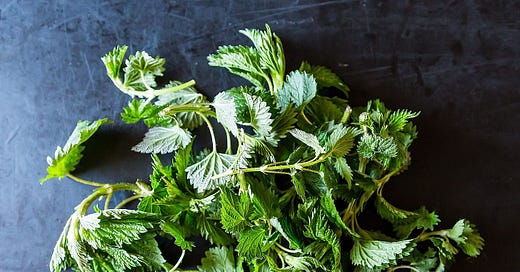My body craves the deep green infusion (medicinal tea) of stinging nettle in early spring. I drink at least two cups a day starting in late February or early March; an annual ritual to stave off spring allergies, generate energy, and consume light in the form of chlorophyll.
My hands are still buzzing from harvesting stinging nettles in an area of Western Massachusetts I call ‘The Pretty Place.’ I highly, highly recommend using gloves to harvest this spring tonic but I like the sensation. The stems and leaves of stinging nettles are covered with plant hairs that inject a mix of formic acid, histamine, acetylcholine, and serotonin and can cause a burning rash that may last up to 12 hours (test a tiny amount on your skin before harvesting glove-free!). It may sound brutal but the nettle sting is a centuries-old treatment called urtication used to relieve pain and bring feeling to areas of the body that have become numb.
The sting is the plant’s own defense mechanism, of course. Heating or cooking the fresh leaves makes them safe for us to consume.
THE MEDICINE
As a medicinal herb, stinging nettles stimulate blood flow and are a body-wide tonic with an affinity for our kidneys and adrenals. Nettles’ high vitamin, mineral, and chlorophyll content feed our endocrine glands, build blood, and provide essential nutrients for stressed-out nervous systems. It’s interesting to note that the chemical structure of chlorophyll (which helps plants turn sunlight into food) is similar to hemoglobin, an essential protein in our red blood cells that carry oxygen throughout our bodies.
Nettles provide dense, but easily-assimilated nutrition: iron, potassium, phosphorus, silica, magnesium, manganese, cobalt, selenium, chromium, and sodium, Vitamins A, C, D, K, chlorophyll, B-Complex (except B-12) and a considerable amount of protein. As an energizing spring tonic, regular infusions of nettle are known to strengthen and revitalize weak kidneys, in turn, increasing energy.
A NOTE ON HERBAL INFUSIONS:
Herbal infusions provide the body with easy‑to‑assimilate nutrition. They differ from tea because the plant material is steeped for a longer period of time, which allows for all the medicinal constituents, including vitamins and minerals, to be liberated from the herb. I usually fill a half-gallon mason jar with a generous handful of dried herbs before bed so they can steep through the night for a strong infusion in the morning. Since nettles can be a bit drying for my body’s constitution, I’ve learned to combine them with slimy, moistening marshmallow root.
For those of you who have asked, I’ll be adding general medicine-making guidelines to the ‘Practices’ section of the newsletter later today. In the meantime, I’d love to hear how you’ve worked with stinging nettles and if you’re harvesting some this spring!
Read about Dandelion, a misunderstood spring tonic…
It's spring in the Northern hemisphere. A time to harvest roots, plant seeds, and renew relationship with the land under our feet. It is an opportunity to learn about the ecosystems that support us and maybe even rewire our perception of so-called weeds.
.







I am suprised to know that nettles are already growing! wow. This is a lovely reminder to start drinking nettle infusions :)